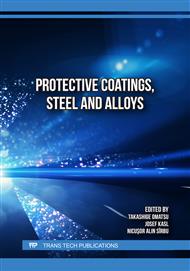[1]
Ruiguan Lin, et al., Knowledge representation and reuse model of civil aircraft structural maintenance cases, Expert Systems with Applications 216, (2023), 119460.
DOI: 10.1016/j.eswa.2022.119460
Google Scholar
[2]
Valentyn Uchanin and Orest Ostash, Development of electromagnetic NDT methods for structural integrity assessment, Procedia Structural Integrity 16, (2019), p.192–197.
DOI: 10.1016/j.prostr.2019.07.040
Google Scholar
[3]
New S-Curve and Manpower development policy direction of country 2020-2024, Bangkok: Printable, NXPO (Ministry of Higher Education, Science, Research and Innovation), (2020).
Google Scholar
[4]
Asa Prateepasen, Non-destructive testing in welding and research, Bangkok: Chulalongkorn University Printing House, (2011).
Google Scholar
[5]
Wenchen Xu, et al., Combination of eddy current and heat treatment for crack healing and mechanical-property improvement in magnesium alloy tube, Journal of Magnesium and Alloys 9 (2021), p.1768–1781.
DOI: 10.1016/j.jma.2020.08.022
Google Scholar
[6]
Ali Sophian, et al., Design of a pulsed eddy current sensor for detection of defects in aircraft lap-joints, Sensors and Actuators A 101, (2002), p.92–98.
DOI: 10.1016/s0924-4247(02)00195-4
Google Scholar
[7]
Yuto Noguchia, et al., Applicability of eddy current technique in in-bore NDT tool for ITER hydraulic pipe welds, Fusion Engineering and Design 146, (2019), p.2571–2576.
DOI: 10.1016/j.fusengdes.2019.04.044
Google Scholar
[8]
Wenlu Cai, et al., Quantitative evaluation of electrical conductivity inside stress corrosion crack with electromagnetic NDE methods, Royalsocietypublishing.org/journal/rsta, 11 May, (2020), pp.1-13.
Google Scholar
[9]
Rúben Filipe Costa Menezes., Eddy Current Method for the Assessment of Crack Depths in Metallic Non-ferromagnetic Plates, Thesis to obtain the Master of Science Degree in Aerospace Engineering, May 2015.
Google Scholar
[10]
Cherdpong Jomdecha, et al., A numerical study on eddy current signal characteristics of imitative stress corrosion cracks, International Journal of Applied Electromagnetics and Mechanics 55, (2017), p.257–269.
DOI: 10.3233/jae-170066
Google Scholar
[11]
Kittawee Nurinram and Supatad Ekmahachai, Manufacturing a defect for eddy current testing (ECT) on a drilled hole in machinery, This project submitted in partial fulfilment of requirement for the bachelor of engineering in division of industrial engineering, Faculty of engineering, Rajamangala University of Technology Krungthep. (2022).
Google Scholar
[12]
2021 ASME Boiler and Pressure Vessel Code, Section V: Nondestructive Examination, (ASME SEC.V ARTICLE 8).
Google Scholar
[13]
Rittichai Phaoniam, et al., Studying Weld Solidification Cracking on Al 6063 for Eddy Current Testing in Aircraft Component Maintenance, The 7th Rajamangala Manufacturing & Management Technology Conference 2022. Kantary Hotel, Korat. 6-8, July, (2022), pp.219-220.
Google Scholar
[14]
K. Masuda, et al., "Investigation of subsurface fatigue crack growth behavior of D2 tool steel (JIS SKD11) based on a novel measurement method", International Journal of Fatigue, Vol.133 (2020), 105395.
DOI: 10.1016/j.ijfatigue.2019.105395
Google Scholar
[15]
Vitor Manoel A. Silvaa, et al., "Eddy current characterization of cold-worked AISI 321 stainless steel", Journal of Materials Research and Technology, (2018); 7(3), pp.395-401.
DOI: 10.1016/j.jmrt.2018.07.002
Google Scholar
[16]
Rittichai Phaoniam, et al., "Evaluation of weld solidification cracking resistance based on high temperature ductility curve", Kasem Bundit Engineering Journal, Vol.8, No.3, September-December, (2018), pp.152-166.
Google Scholar
[17]
S. H. Chen, et al., "Hydrogen sulphide stress corrosion cracking of TIG and laser welded 304stainless steel", Corrosion science, Vol. 36, No.12, (1994), pp.2029-2041
DOI: 10.1016/0010-938x(94)90006-x
Google Scholar
[18]
Morteza Taheri, et al., "Effect of Nd:YAG Pulsed-Laser Welding Parameters on Melting Rate of GTD-111 Superalloy Joint", Journal of Materials Engineering and Performance, Pulished online; 17 August 2021. pp. xx-xx.
DOI: 10.1007/s11665-021-06099-z
Google Scholar


